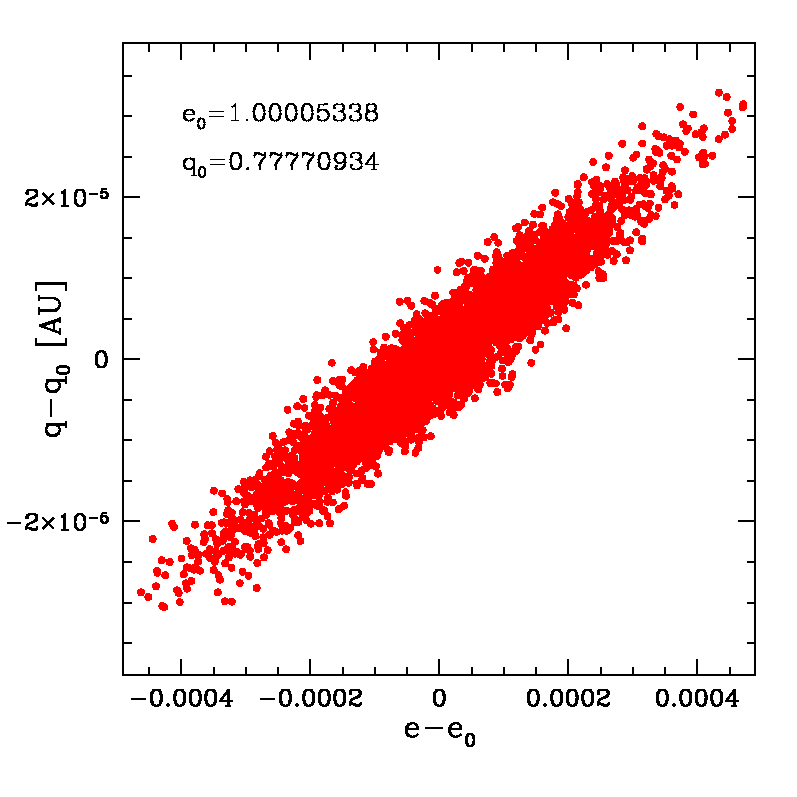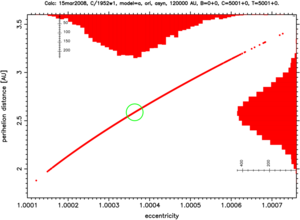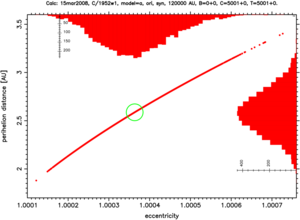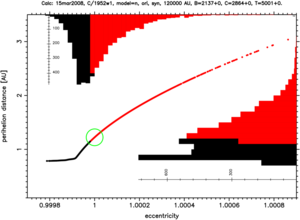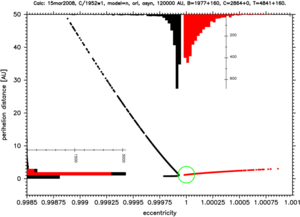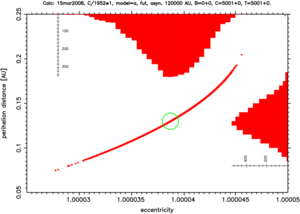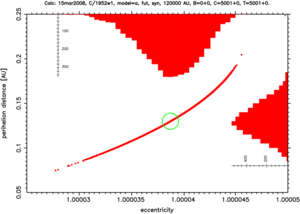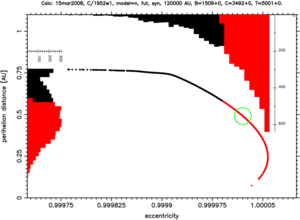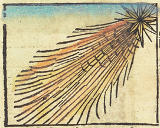Nongravitational nominal solution
Obs. arc: 1952 12 10 - 1953 07 18 Number of obs: 36 RMS: 1.08 arc second, (61 residuals used, 15.3% rejected residuals)
Heliocentric osculating orbit
Epoch Perihelion time q e ω Ω i
1953 01 23 19530124.861090 0.77770934 1.00005338 253.822072 343.580012 97.186308
± 0.000716 0.00001008 0.00014581 0.000446 0.000890 0.000812
NG parameters:
A1= (3.8399 ± 1.9048) 10-8 AU/day2
A2=(-0.48851 ± 0.18115) 10-8 AU/day2
A3= 0 (assumed)
Barycentric nominal original orbit (at 250 AU from the Sun)
Epoch Perihelion time q e ω Ω i
1655 04 15 1953 124.009962 0.77523403 1.00000006 253.926416 344.352039 97.169311
± 0.001204 0.00003669 0.00006650 0.003436 0.000900 0.000824
1/aori = (-0.07 ± 85.78) 10-6 AU-1
Barycentric nominal future orbit (at 250 AU from the Sun)
Epoch Perihelion time q e ω Ω i
2250 05 26 1953 125.074189 0.77661881 1.00003215 253.739321 344.211006 97.128729
± 0.002219 0.00004214 0.00008305 0.004184 0.000894 0.000825
1/afut = (-41.39 ± 106.94) 10-6 AU-1
In the 17th edition of the Catalogue of Cometary orbits (2008):
Gravitational orbit (64 obs.) with negative 1/aori - original barycentric orbit - hyperbolic.
The same comet in some other internet sources:
More details
Starting swarms of VCs...(heliocentric, osculating orbits)
Original and future orbit at the 250 AU from the Sun.
Comet number 6 in the Table: Non-gravitational Oort spike comets (26 objects)
| Name | GR (1/a)ori [10-8 AU/day2] | GR (1/a)osc [10-8 AU/day2] epoch [TT] | GR 1/afut [10-8 AU/day2] | RMSGR [arcsec] | NG (1/a)ori [10-8 AU/day2] | NG (1/a)osc [10-8 AU/day2] epoch [TT] | NG 1/afut [10-8 AU/day2] | RMSNG [arcsec] | NG parameters A1 A2 A3 [10-8 AU/day2] tau shift [day] | |
| 6 | C/1952 W1 Mrkos weighting | -140.69 ± 21.69 | -456.98 ± 21.67 1953 01 23 | -298.66 ± 21.69 | 1.14 | -0.07 ± 85.78 | -68.64 ± 187.49 1953 01 23 | -41.39 ± 106.94 | 1.08 | 3.8399 ± 1.9048 -0.4885 ± 0.1811 |
Note: in the following plots black denotes returning clones while red denotes escaping ones.The nominal solution is located at the center of the green circle. Each plot have a header where date of calculation and some other parameters are coded. Also numbers of returning (B=shown+omitted), escaping (C=shown+omitted) and all (T=shown+omitted) Vcs are shown.
Past orbits, at previous perihelion for the returning VCs :
Future orbits, at next perihelion for the returning VCs:

